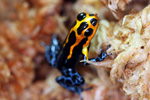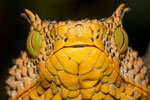
Male Calotes bachae. Photo by Peter Geissler.
German and Russian biologists have discovered a stunning new species of lizard in Vietnam. The species, dubbed Calotes bachae, is described in a recent issue of the journal Zootaxa.
Calotes bachae is a type of agama, a group of lizards commonly known as “forest dragons.” It was described after DNA research led by Timo Hartmann, a PhD candidate from the Museum Koenig in Bonn, Germany, revealed it was genetically distinct from another blue lizard species found in Myanmar and Thailand. In other words, it is what scientists call a cryptic species — one that has been hiding in plain sight.
Calotes bachae is not particularly rare nor difficult to find, according to the zoologists.
“To observe the new species no exhausting march into the remote rainforests of Vietnam is necessary. These lizards seem to have arranged themselves well with humans, even in the centre of the metropolis Ho Chi Minh City one can find them within parks and flower beds”, said study co-author Peter Geissler, also a PhD candidate at Koenig.

Map showing sites (black diamonds) where Calotes bachae was collected as well as sites (white markers) where the closely related Calotes mystaceus is found. There are at least 23 species in the Calotes genus. Courtesy of Hartmann et al. (2013).
Calotes bachae is a small lizard, measuring up to 4 inches (10 cm) in length. Like many other agamids, males are characterized by bright colors during the mating season. Females and juveniles are drabber in coloration. Both males and females are capable of changing colors to better match their surroundings. For example at night, Calotes bachae is typically dark brown.

B) Adult female in Dong Nai Province, Vietnam. Photo by Peter Geissler. C) Adult male during breeding season, Dong Nai Province. Photo by Peter Geissler. D) Adult male in Binh Phuoc Province, Vietnam. Photograph by Nikolay Poyarkov. E) Juvenile in Dong Nai Province, Vietnam. Photo by Peter Geissler.
The discovery provides another example of the utility of new tools like DNA-barcoding in distinguishing species, according to Nikolay Poyarkov, another co-author of the study.
“The full species richness of our planet is not nearly recorded yet”, added Rödder, Head of the Herpetology Department at the Museum Koenig.
Hundreds of previously unknown species have been discovered over the past decade in the Mekong region. Last week Australian scientists announced the discovery of a giant flying frog, also from Vietnam.
CITATION: Timo Hartmann et al. (2013). A new species of the genus Calotes Cuvier, 1817 (Squamata: Agamidae) from southern Vietnam. Zootaxa 3599 (3): 246–260; doi: 10.11646/zootaxa.3599.3.3
Related articles
Photos: 3 colorful lizard species discovered in Australia
(12/19/2012) Researchers in Australia have described three new lizard species from the northwestern part of the continent.
Pictures: 126 new species discovered in Greater Mekong region last year
(12/18/2012) Some 126 new species were described in Asia’a Mekong region last year, notes a new report published by the World Wildlife Fund (WWF).
Artificial ‘misting system’ allows vanished toad to be released back into the wild

(11/01/2012) In 1996 scientists discovered a new species of dwarf toad: the Kihansi spray toad (Nectophrynoides asperginis). Although surviving on only two hectares near the Kihansi Gorge in Tanzania, the toads proved populous: around 17,000 individuals crowded the smallest known habitat of any vertebrate, living happily off the moist micro-habitat created by spray from adjacent waterfalls. Eight years later and the Kihansi spray toad was gone. Disease combined with the construction of a hydroelectric dam ended the toads’ limited, but fecund, reign.
Remarkable comeback: blue iguana downgraded to Endangered after determined conservation efforts
(10/23/2012) The wild blue iguana population has increased by at least 15 times in the last ten years, prompting the IUCN Red List to move the species from Critically Endangered to just Endangered. A targeted, ambitious conservation program, headed by the Blue Iguana Recovery Team, is behind this rare success for a species that in 2002 only numbered between 10 and 25 individuals.
Scientists name new snake species to criticize mine plans in Panama (photos)

(09/18/2012) While scientists increasingly name new species after celebrities in order to gain much-needed attention for the world’s vanishing biodiversity, researchers describing a new snake species from Panama have taken a different route. Dubbing the new serpent, Sibon noalamina (‘no to the mine!’ in Spanish), the scientists are hoping the multicolored snake’s unusual name will draw attention to mining and deforestation issues in Panama’s remote Tabasará mountains.
‘Penis snake’ discovered in Brazil is actually a rare species of amphibian
(08/02/2012) A creature discovered by engineers building a dam in the Amazon is a type of caecilian, a limbless amphibian that resembles an earthworm or as some are noting, part of the male anatomy.
3000 new species of amphibians discovered in 25 years
(07/31/2012) The number of amphibians described by scientists now exceeds 7,000, or roughly 3,000 more than were known just 25 years ago, report researchers in Berkeley.
The dark side of new species discovery

(12/21/2011) Scientists and the public usually rejoice when a new species is discovered. But biologist Bryan Stuart has learned the hard way that the discovery of new species, especially when that species is commercially valuable, has a dark side-one that could potentially wipe out the new species before protections can be put in place. Stuart has discovered 27 species unknown previously to scientists – so far. That includes 22 species of frogs, three types of snakes, and two salamanders. His experience with one of these, a warty salamander from Laos with striking markings (Laotriton laoensis), opened his eyes to a dark side of scientific discovery: commercial overexploitation before protections are in place. Shortly after Stuart described the previously unknown species Paramesotriton laoensis in a scientific paper published in 2002, commercial dealers began collecting this Lao newt for sale into the pet trade. In essence, the dealers used Stuart’s geographic description in the paper as a “roadmap” to find the rare newt.
New large horned viper discovered, but biologists keep location quiet

(12/15/2011) In a remote forest fragment in Tanzania, scientists have made a remarkable discovery: a uniquely-colored horned viper extending over two feet long (643 millimeters) that evolved from its closest relative over two million years ago. Unfortunately, however, the new species—named Matilda’s horned viper (Atheris matildae)—survives in a small degraded habitat and is believed to be Critically Endangered. Given its scarcity, its discoverers are working to pre-empt an insidious threat to new species.
Giant snakes commonly attacked modern hunter-gatherers in Philippines

(12/13/2011) Humans have an ambivalent relationship with snakes. The legless reptiles are often feared and reviled, becoming stand-ins for the Devil and movie monster characters; yet many people have grown to love snakes, raising large, even dangerous, specimens as pets. Now, new research suggests that the ecological role between snakes and humans, as well as other primates, is more nuanced than expected. After spending decades living among the Agta Negritos people in the Philippines, anthropologist Thomas Headland has found that the hunter gatherer tribes were quite commonly attacked by reticulated pythons (Python reticulatus), while the people themselves had no qualms with hunting, killing, and consuming python.














